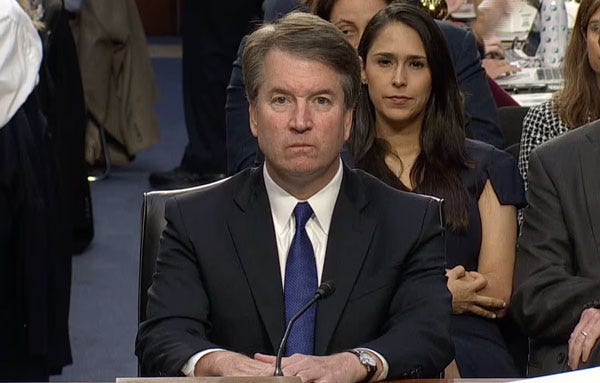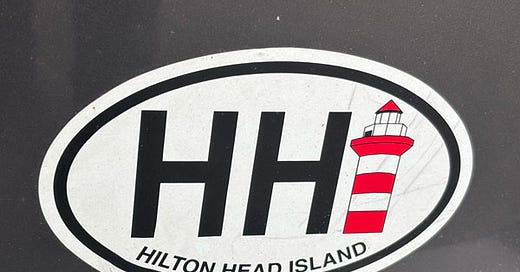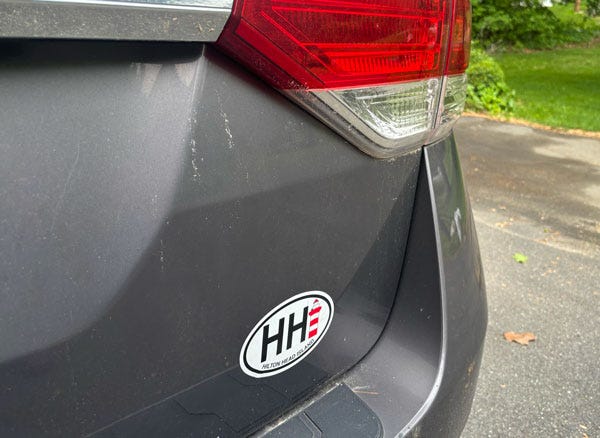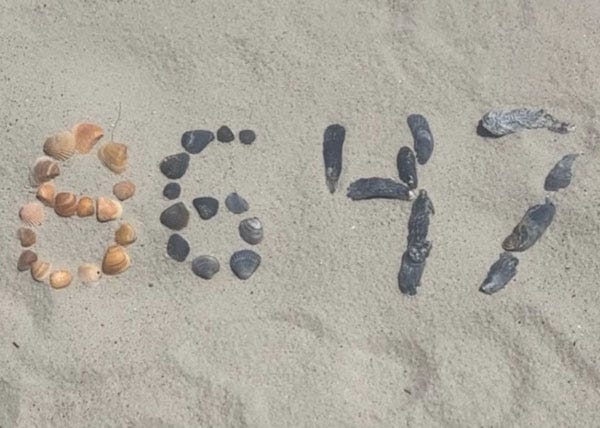Welcome to another edition of Willoughby Hills!
This newsletter explores topics like history, culture, work, urbanism, transportation, travel, agriculture, self-sufficiency, and more.
A few years ago, I added a bumper sticker to my beloved Honda Odyssey minivan. Here’s what it looks like:
The bumper sticker is from Hilton Head, South Carolina, an island resort community on the Atlantic Coast.
At the time I added the sticker, some time before the start of the pandemic, we had vacationed in Hilton Head three or four times and really enjoyed spending time there. It was a place we revisited often and imagined ourselves continuing to visit (though the pandemic and the arrival of a new puppy altered those future plans).
We used to vacation at a beautiful resort on a marsh, where we could look out of our hotel room window and watch birds swoop in and out of the grasses. There were incredible beaches nearby, plus plenty of fresh seafood. We would rent bikes and explore the island, or could just sit in a hammock with a good book. When our kids were younger, they loved visiting the children’s museum and even the local playgrounds. It was a great family vacation spot.
Hilton Head was ingrained in me as a child growing up in Northeast Ohio. Every school break, at least one classmate seemed to be going there to relax, golf, or swim (often it was several classmates). Salty Dog Cafe T-shirts rivaled clothes from the Gap and Abercrombie and Fitch in my elementary and middle schools.
Apparently, when Hilton Head was being developed into a resort community in the 1970s, one of the builders specifically targeted marketing messages to people in Ohio, even though it was a full day’s drive away. Somehow, those messages stuck and Buckeye Staters have been flocking to South Carolina ever since. I only went once as a child, but I knew friends that went annually for many years.
Strangely, even though Hilton Head was a huge destination in Ohio, it’s virtually unknown here in New England, where I live now. People here either head to Maine or Cape Cod for local beaches or visit Florida for tropical beaches. They seem to miss everything in between, from the Jersey Shore to Virginia and Myrtle Beaches to Hilton Head.
My bumper sticker is a common design for folks who vacation in Hilton Head, meant to spell out “HHI” for Hilton Head Island. The H’s are in black block letters, but the I is the Harbour Town Lighthouse, an icon of the island. In case there was any confusion, “Hilton Head Island” is written below the letters in a smaller font.
For years, I drove around with this sticker without giving it a second thought.
Sometime in recent years, I began hearing that white supremacists were using “HH” as a shorthand with each other (short for “Heil Hitler”). 88 is even more well known and widely used in white supremacist groups, with H being the eighth letter of the alphabet, so 88 standing for two Hs.
Every time I got in my van after learning that, I looked at the bumper sticker and wondered. Sure, my sticker was supposed to be “HHI”, but it was really just two block letter H’s with a lighthouse. It read more like “HH” than “HHI.”
For a while, I thought maybe I was the only one who noticed, that I was being overly sensitive or was too plugged in to internet meme culture. But then one day at my kids’ school, a parent came up to me and asked “So, what’s with the HH sticker?”
I explained that it was for Hilton Head Island and that it actually said “HHI” with the lighthouse acting as the I. That seemed to satisfy the inquiry. The other parent never said as much, and I never let on that I was aware, but I couldn’t help but wonder if they were trying to feel out if I was a secret white supremacist.
As of now, I still have the bumper sticker on my van and have wondered what to do about it. Everything that I’ve read about removing bumper stickers say it’s a dicey operation that can result in lasting damage to the paint job on a car (perhaps that’s why I still occasionally see a “Kerry/Edwards 2004” or “McCain/Palin 2008” bumper sticker on old cars).
But there’s also a part of me that’s annoyed that racists get to keep taking perfectly normal, innocuous things from the rest of us. There was no problem with the letter H until very recently, unless somebody was directly involved in a white supremacist group and saw it as some kind of secret sign.
Look up the definition of HH, and you’ll get about 1,000 different answers for this acronym, very few of them racist.
The official dictionary definition of HH is an abbreviation for His (or Her) Highness, as in HH King Charles, but it can also mean His Holiness, as in HH The Dalai Lama.
In internet slang, it can be an abbreviation for “holding hands” and is also a way to say “Heh Heh,” which is a slight laugh that’s not quite an LOL.
HH can be the initials for everybody from Hulk Hogan to Herbert Hoover to Helen Hunt. It also appears to be a common abbreviation for Happy Hour, though Happy Hours have been banned in Massachusetts since 1984, so it’s understandable that I’m less familiar with this term.
HH is emblazoned on the front of nearly every article of clothing made by Norwegian apparel brand Helly Hansen. They were founded in 1877, more than a decade before Hitler was even born.
It reminds me a bit of how the “okay” hand gesture has become problematic in recent years. It used to be a normal part of life and using it was completely innocuous. But now if a White House intern or a clerk to a Supreme Court nominee makes that hand gesture, it’s seen as either affirming white supremacy or at least provoking those who oppose white supremacy.

I often work with a director of photography that gives me the okay sign to indicate that the camera is rolling, using it essentially the same way one would use a thumbs up. I’ve never seen him demonstrate any other form of racist or problematic behavior, so I take his use of it at face value. I don’t think he has any ill intent; I honestly doubt he’s even aware that it’s considered controversial these days.
Aside from folks who are terminally online or who operate in racist or anti-racism spaces, I’m not sure that most people even realize the implications of HH, 88, or the okay hand symbol. I certainly didn’t know the alternate meanings of any of these until recently.
It reminds me a bit of the recent controversy surrounding former FBI director James Comey, after he posted a photo of seashells on a beach arranged to show “8647.” Some people took this as a threat against Donald Trump (our 47th president), with “86” being a common restaurant term for cancelling or omitting something, but also a less common term for killing.
After it was pointed out what the interpretation could be, Comey pulled the post and issued this statement:
“I posted earlier a picture of some shells I saw today on a beach walk, which I assumed were a political message. I didn’t realize some folks associate those numbers with violence. It never occurred to me, but I oppose violence of any kind, so I took the post down.”
Which leads me back to my bumper sticker. What to do now that I know it might mean something racist. Should I try to remove my bumper sticker, risking damage to my car? Should I cover it with something else? Or do I leave it alone for now, knowing that I’m referencing Hilton Head Island, not something more nefarious?
I’m guessing some of you reading this have strong opinions one way or another, while others are probably wondering why I’ve spent this many words and this much time even giving the matter a second thought. I’d love to hear your thoughts- good, bad, or indifferent. Please leave a comment and let me know what you think.
Side note: Even if “HH” hadn’t been coopted by white supremacists, it’s important to also acknowledge the racist history of Hilton Head.
Before European settlement, it served as seasonal hunting and fishing grounds for Indigenous Americans.
Upon European arrival, these islands were abandoned for safer land further from the coast. White settlers built and maintained large plantations with enslaved African people.
Within these enslaved communities, a distinct language and culture influenced by West Africa was formed, known as Gullah/Geechee. Many of the white landowners were absentee or fled during the Civil War, and the Gullah/Geechee were some of the first Black Americans to own land. Their culture thrived on Hilton Head and the surrounding area until the Great Depression.
Developers purchased these lands in the twentieth century, displacing the Gullah/Geechee and replacing their homes with luxury vacation rentals and hotels, like the one I visited.
So Hilton Head, like vacation destinations from Jackson Hole to Waikiki, has its own history of displacement and gentrification which also deserves examination, even without the symbolism of its letters.
Thanks for reading Willoughby Hills! Subscribe for free to receive new posts and support my work.
Related Reading
If you’ve missed past issues of this newsletter, they are available to read here.









Take a Sharpie and draw a line through the lighthouse to look like an I.
I have visited HHI only once and found it to be the epitome of gentrification. There are parts of the island (the part with the iconic lighthouse) that visitors have to pay a fee to drive to. Many of the mansions are far from the road and camouflaged by trees so they can’t be seen. There is very little public access to beaches and the ocean. I found it to be an unwelcoming place with an overwhelming feeling of snobbery and a clear message that I didn’t belong. I’ve never been back.